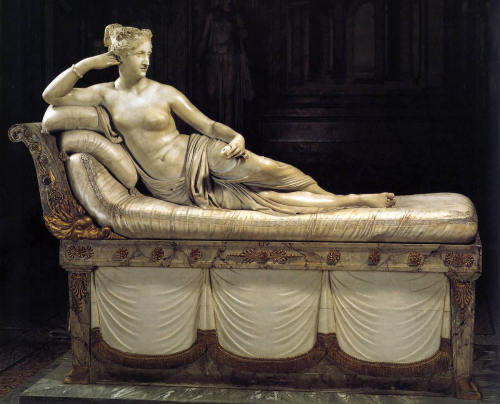As bees their sting, so the promiscuous leave behind them in each encounter something of themselves by which they are made to suffer.
~Cyril Connolly
Good girls go to heaven, bad girls go everywhere.
~Mae West, Wit & Wisdom of Mae West

Marie-Pauline Bonaparte Borghese was born into a large French family in the late 18th century. Her father was a lesser nobleman, and when he died the family was left destitute. There are stories that Pauline and her mother had to make money taking in laundry.
Pauline was the younger -- and favorite -- sister of Napolean Bonaparte. As he rose to prominence in the French army, he assisted Pauline in entering society. He arranged her first marriage to another Frenchman, General Charles LeClerc. They had one son, Dermide. As Napolean's military career advanced and retreated, so went Pauline's life. She was apart from her husband most of the time, and was at times in physical danger because of all the warring that was going on. During this time, Pauline began taking lovers at a rather astonishing rate, despite her contracting Yellow Fever. When her husband, Le Clerc, died, she rebelled at the protocol of mourning to the point where her brother, now Emperor, felt it necessary to find her another husband quickly. He again arranged a marriage, this time to Camillo Borghese, 6th Prince of Sulmona, a wealthy Roman noble. Indeed, the Borghese family in Italy was similar to the Vandberbilts in the US. They were rich, powerful, friends of the Pope and nobility.
Pauline continued her lifestyle of parties, excessive luxuries and paramours at such a legendary pace that her husband left Rome and took up residence in Florence with his own mistress. Stories of her exploits are legendary. She posed for the statue below, which then was prominently displayed at the Borghese villa, much to the scandal of society. When asked by someone viewing it, "Pauline, were you not uncomfortable posing for such a statue?" she replied, "Why no! The room was perfectly warm!"
Pauline's son died before adulthood, and she died a fairly young woman. She was estranged from her husband, given only one apartment in Florence in which to reside (the Borghese family had homes all over Italy, including a villa next to the Vatican and a huge palace elsewhere in Rome). She was rebuked by society for her promiscuous behavior. At her death, only her brother, out of power and in exile, was close to her. A beautiful young woman who rose from poverty to attain more worldly goods than most died an outcast.
While in Florence, our tour group was treated to a "Renaissance Dinner" in Pauline's apartments. The dinner was delicious. There was entertainment in the form of Renaissance music (flute, harpsicord and other tympany). And the setting was the beautifully maintained early 19th century apartments, complete with guilded ceilings and exquisite crystal chandeliers (now electrified for safety...). We were told the story of Pauline after dinner, having dined in what was her boudoir. Here are a few photos from that evening...
 |
| The jester came around with various games and tricks, and engaged a lot of us in pranks to the amusement of the rest of the group. |
 |
| Carrying in the meat entre to much fanfare |






No comments:
Post a Comment